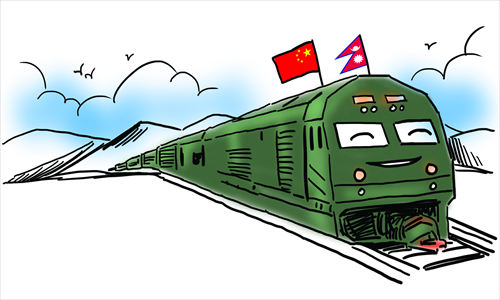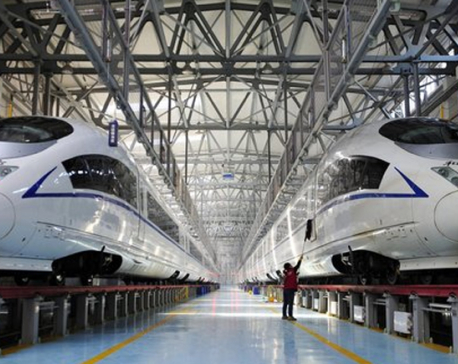
OR
Nepal-China rail link


Gaurav Bhattarai
The author is Assistant Professor at the Department of International Relations and Diplomacy, Tribhuvan University.news@myrepublica.com
The train will bring cheap Chinese goods. But will we then send it back empty on its return leg?
As China is all-set to extend its Qinghai-Tibet railway up to Nepal border point of Kerung by 2020, this is the right time to ask what Nepal plans to send back to China when the train reaches Kerung.
The whistling train will bring low-priced Chinese goods into Nepal. But will we then send the train back empty on its return leg?
Nepal only exports small quantities of goods like iron, steel, tea, coffee, spices, carpet, footwear, textile, plastic, clothing, accessories, handicraft, beverage and vegetable. Can we significantly scale up the production of these goods to meet the huge demand of Chinese markets? And will they be able to compete against Chinese products? If Nepal’s exportable goods can’t compete in core Chinese markets, then will the aforementioned goods be traded in Tibetan Autonomous Region (TAR) of China alone?
Even historically, Nepal’s trade was limited to Tibet. But bilateral trade relies on the interplay of demand and supply. Without understanding the core demands of TAR, indiscriminately dispatching goods would not be wise. Categorization and compartmentalization of goods is essential. Green vegetables are in great demand in Tibet. So there should be proper cost-benefit analyses in terms of the production and transport of these goods. Exporting goods, which are already available at low prices in Tibet, does not make much economic sense.
Now, 2020 is not far-off and Nepal has officially joined China-led One Belt One Road (OBOR), which aims at enhanced connectivity and cooperation between China and the rest of the world. In case of Nepal-China bilateral relation, OBOR provides China a strategic route to enter South Asian markets, through the building and upgrade of Nepal’s physical infrastructure. Extension of Qinghai-Tibet railway to Nepal border is an effort in this direction.
China is eager to extend the railway up to India via Nepal. Although India is currently hesitant about any proposed trilateral partnership, Chinese academics have already started touting the great benefits of China-India-Nepal economic corridor under the OBOR framework. India does not want to join OBOR as yet, but she is already a founding member of China-sponsored Asian Infrastructure Investment Bank (AIIB).
While India believes that proposed trilateral partnership is not in her interest, China is encouraged by the idea, which was first proposed by Nepal in 2013.
Even at Indo-Nepal trading points, India tries to undermine any trilateral arrangement. India prohibited the import of ginger from Nepal in September 2016, as Chinese gingers, India accused, were being exported to India in the name of Nepali merchandise.
Earlier, Chinese scholars used to see Nepal as a bridge between China and India. But these days, they prefer to see Nepal as a bridge between China and South Asia. Extension of Qinghai-Tibet railway to Nepal border by 2020 will be the first big effort to join Nepal and China through rail links.
Indeed, on May 12, 2016 China opened its first rail-and-road service from Lanzhou of Gansu Province in Northwest China to Nepal: the 2,431 kilometers from Lanzhou to Shigatse were covered by rail, while 564 the kilometers from Shigatse to Kerung were covered by road transport. Remaining 160 kilometers from Kerung to Kathmandu was also road transport. The goods had arrived at Kerung after a week-long journey from Lanzhou.
For sea freight, Nepal was until recently solely dependent on Kolkata port. Today, it also has access to Tianjin port of China and Vishakhapatnam port of India. Tianjin is 3,300 km from Nepali border, as against the Kolkata port that is only 1,000 km from Nepal. So, on first glance, using Kolkata makes business sense. But we need to assess shipment costs as well. It takes up to 35 days for shipment of Chinese goods to arrive in Nepal via Kolkata, while it can reach Kathmandu via Kerung in no more than 10 days. In comparison to the Kolkata port, easy accessibility and availability of all global goods at the Tianjin Port—which trades with over 600 ports in 180 countries—is expected to significantly bring down Nepal’s shipment costs.
The Chinese train is the best means to diversify Nepal’s trade relations by ending its asymmetric dependence on India. Still, caution is advised. First, international trade law doesn’t allow Nepal to export the imported Indian-manufactured goods to China for a profit, or to profitably sell imported Chinese-made goods in Indian markets. Second, embracing all Chinese goods imported via train will simply lead to a surge in Nepal’s imports and consequent worsening of our balance of payment.
Hence the question of what Nepal plans to send back in those Chinese trains that will soon be arriving at Kerung is extremely important.
The author is a faculty at TU’s Masters in International Relations and Diplomacy (MIRD) program
You May Like This

General Manager Jha's complaint: Govt did not help railway company
KATHMANDU, August 25: Niranjan Kumar Jha, the general manager of Nepal Railway Company, has complained that the Ministry of Finance... Read More...

China's top train maker receives order from India
DALIAN, April 2: An affiliated company under China's top train maker CRRC Corporation has acquired a subway train order from... Read More...

At least 4 dead in southern Italy train crash
MILAN, July 12: Italian news reports say that two trains have collided head-on in the southern region of Puglia, killing... Read More...




Just In
- Govt receives 1,658 proposals for startup loans; Minimum of 50 points required for eligibility
- Unified Socialist leader Sodari appointed Sudurpaschim CM
- One Nepali dies in UAE flood
- Madhesh Province CM Yadav expands cabinet
- 12-hour OPD service at Damauli Hospital from Thursday
- Lawmaker Dr Sharma provides Rs 2 million to children's hospital
- BFIs' lending to private sector increases by only 4.3 percent to Rs 5.087 trillion in first eight months of current FY
- NEPSE nosedives 19.56 points; daily turnover falls to Rs 2.09 billion















Leave A Comment